Stone Sculpture at Treblinka

Stones recreate railroad
ties for spur line into Treblinka camp
After you pass through the two large
stones set at an angle to form an entrance gate into the area
where the Treblinka camp once stood, you come upon an immense
stone sculpture designed to represent the railroad ties on which
the tracks were laid on the spur line that the Germans built
from the Treblinka station into the camp. The tracks begin in
the wooded area outside the camp boundary line, as shown in the
photo above, and then make a sharp turn to the left (eastward)
into the camp, as shown in the photographs below. The stones
in the second photo below represent the camp boundary line.
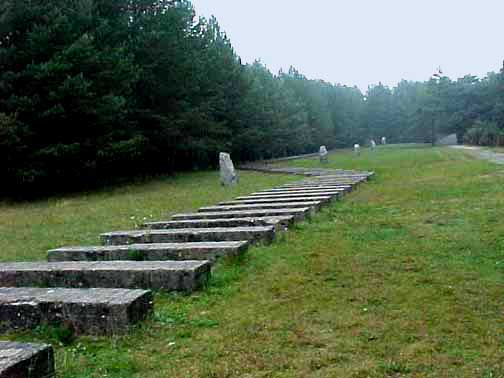 Stones represent the
train tracks into the Treblinka camp
Stones represent the
train tracks into the Treblinka camp
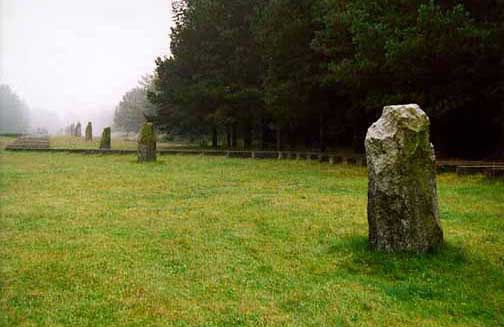 Stone railroad ties
make sharp turn and continue inside camp
Stone railroad ties
make sharp turn and continue inside camp
The photograph below shows the end of
the railroad spur line with a stone platform to the left. When
the camp was in operation, there was a real train platform in
this spot and behind it was a storehouse, disguised as a train
depot, which was used to store the clothing and other items which
the victims had brought with them to the camp. In the background
of the photo below, you can see another line of 10 stones which
mark the southern boundary line of the camp. The stones represent
the different countries, including German-occupied Greece, Bulgarian-occupied
Greece, Czechoslovakia, Poland, Belgium, France, Germany, Austria,
Yugoslavia and the Soviet Union, from which the Jews were transported
by train to be exterminated here in this remote, God-forsaken
spot in the forest.
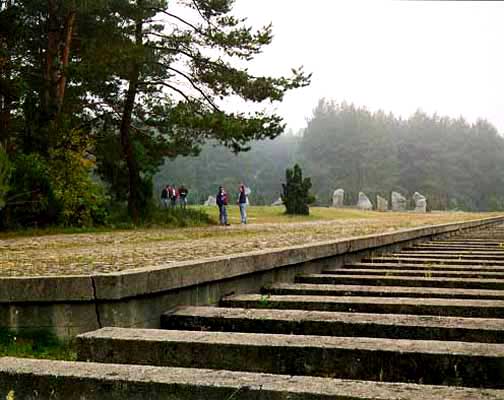 Polish students stand
where fake train station once stood
Polish students stand
where fake train station once stood
The Treblinka camp was divided into three
sections. On the far left of the platform where the Jews arrived
was the section where the guards and administrators lived. The
1,000 Jews who worked at Treblinka lived in Camp 1 to the right
of the SS barracks on the map below. Today, only the area on
the far right of the map below, where the Jews were gassed and
burned, has been preserved; the rest of the camp is now covered
with trees. The whole camp covered about 22 acres and today's
visitors see an area that is about 7 acres in size.
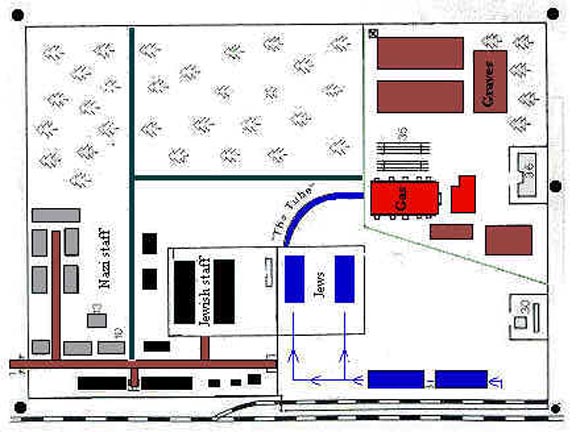 This map has been turned
so that the top of the Map is East
This map has been turned
so that the top of the Map is East
The map above shows the layout of the
Treblinka camp as seen by visitors today who enter the area of
the former camp along the route of the train tracks, shown at
the bottom of the map. Shown in gray on the left side near the
bottom of the map is where the SS staff members and the Ukrainian
guards lived. Around 1,000 Jewish workers lived in the barracks
that are shown in black. The fake train station where the clothing
was stored is shown in blue; the undressing rooms for the Jews
are also shown in blue. On the right side of the map, the burial
sites are shown in brown. The gas chambers are shown in red;
the large red rectangle is where 10 new gas chambers were constructed
near the original gas chamber. Today, a large monument is located
in the spot where the original gas chamber once stood. The pyres
where the bodies were burned are indicated by the lines just
above the red rectangle that denotes the gas chamber. The area
where the barracks once stood is now covered with trees; the
area at the top of the map on the right is where the symbolic
cemetery is now located.
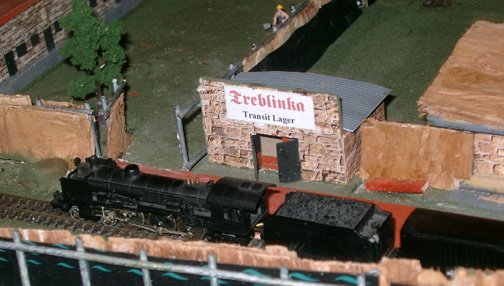 Model of Treblinka
camp
Photo Credit: Adelaide
Institute
Model of Treblinka
camp
Photo Credit: Adelaide
Institute
The photo above shows a model of the
Treblinka camp, which was shown by Richard Krege at the Holocaust
denial conference held in Iran in December 2006.
 Original sign at Treblinka
camp
Photo Credit: Yad Vashem
Holocaust Museum
Original sign at Treblinka
camp
Photo Credit: Yad Vashem
Holocaust Museum
The Jews who were murdered in the gas
chambers at Treblinka were brought here in trains, 60 cars long,
with 100 Jews crammed into each boxcar. The trains stopped at
the Malkinia Y junction where 20 cars would be detached from
the train and backed into the camp via the spur line. After the
passengers were unloaded at the platform beside the tracks, the
train would get the next 20 cars waiting at the junction. On
the return trip, the trains turned south at the Malkinia junction
and took the clothing to the disinfection chambers at the Majdanek
camp in Lublin.
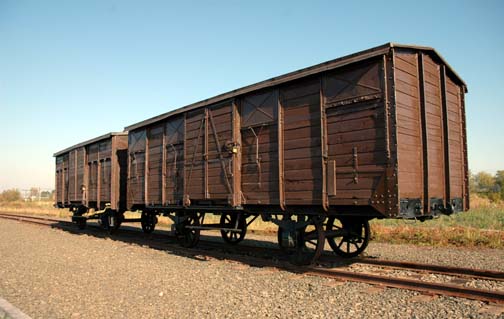 Two original cattle
cars used to transport Jews to death camps
Two original cattle
cars used to transport Jews to death camps
The photo above, taken at Auschwitz-Birkenau
in October 2005, shows two original railroad cars with no windows,
which were the type that were used to transport Jews to the Treblinka
death camp. Many of the victims died of suffocation or dehydration
before the train arrived in the camp.
This page was last updated on March 21,
2009
|